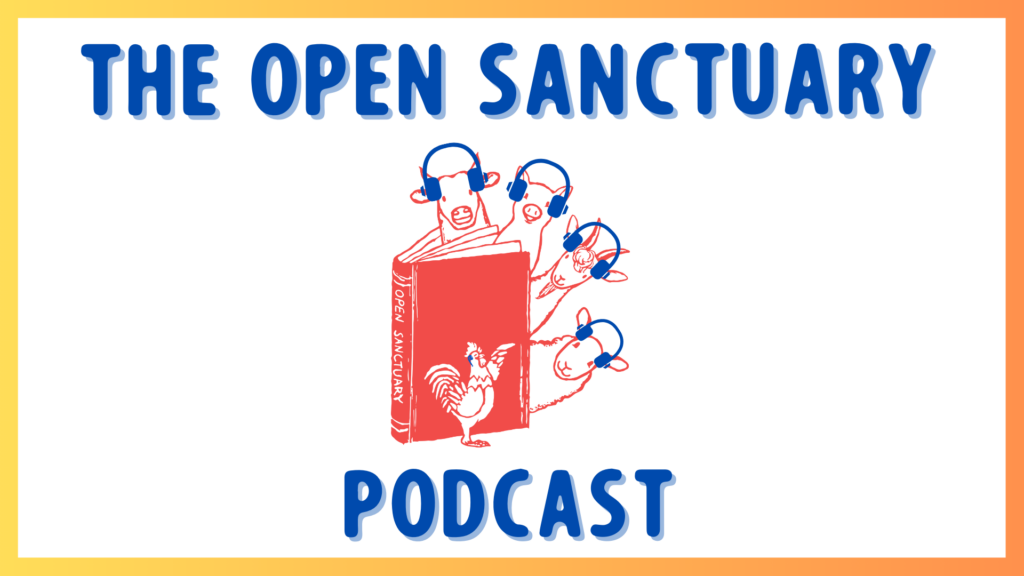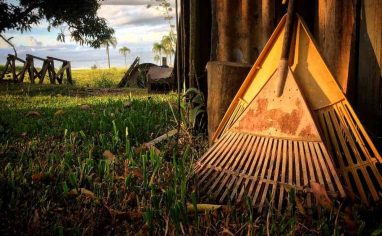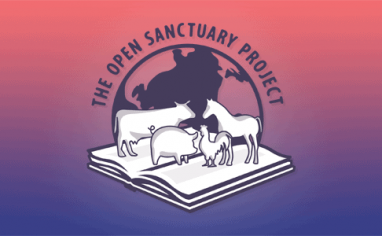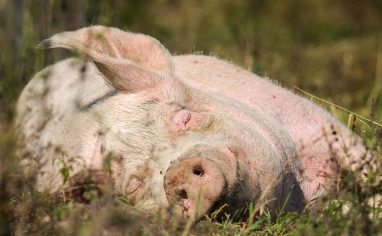
Subscribe To The Open Sanctuary Podcast
If you’d like to get the latest episodes of The Open Sanctuary Podcast, you can subscribe for free on all Podcast platforms, including Apple Podcasts and Spotify!
Episode Notes
Community Education Specialist Andie and NonprofitA non-governmental organization whose primary purpose is something other than selling goods or services. Specialist Julia discuss some helpful strategies and tips on how your animal organization can table at outreachAn activity or campaign to share information with the public or a specific group. Typically used in reference to an organization’s efforts to share their mission. events as effectively as possible. They offer insight on how tabling can be a beneficial way to connect with the public and raise awareness about issues that are important to your organization, actionable tips on how to choose outreach events and tabling staff wisely, and ways to create a welcoming and engaging table atmosphere to draw folks into meaningful conversation with you.
—
This Episode’s Referenced Open Sanctuary Project Resources:
- A Guide To Effective Tabling For Sanctuaries
- An Introduction to Fostering Agency in Farmed Animals at Your Animal Sanctuary
- A Starter Guide to Common Questions Your Sanctuary Gets Asked and How to Thoughtfully Answer Them
- The Importance Of Language Choices At Your Animal Sanctuary
- Communicating With Youth About Animal Exploitation
- An Introduction to Educational Programs and Opportunities Well-suited for Microsanctuaries
- In-Person Sanctuary Educational Programming: What Are Your Options?
- An Introduction To Fostering Agency In Farmed Animals At Your Animal Sanctuary
- Education Program Evaluation for Animal Sanctuaries
Episode Transcript (Auto-GeneratedThe following content was transcribed through an automated process and may contain transcription errors or misspellings.)
Andie Springirth Well, hey there friends, and welcome back to another episode of the Open Sanctuary Podcast. My name is Andie Springirth, and today I’m joined by my friend and colleague Julia Magnus. And if you follow us on social media, you may have noticed that our team was tabling recently at the Animal and VeganAn individual that seeks to eliminate the exploitation of and cruelty to nonhuman animals as much as possible, including the abstention from elements of animal exploitation in non-food instances when possible and practicable as well. The term vegan can also be used as an adjective to describe a product, organization, or way of living that seeks to eliminate the exploitation of and cruelty to nonhuman animals as much as possible (e.g., vegan cheese, vegan restaurant, etc.). Advocacy Summit in Alexandria, Virginia. And as we were prepping for that event, I thought it might be timely, given the fact that we were tabling and also given all the outreach events that tend to happen during this time of year, to talk about tabling with you all on the podcast because we have a resource on our website related to this very topic. So today, more specifically, we want to talk briefly about what tabling is, why you might want to consider doing it if you haven’t already, and how you might consider doing it. So let’s dive in.
Basically, tabling is when you set up a literal table at some kind of community event to create a space for folks who are attending the event to engage in conversation with you. And this is essentially so that the public can have a chance to learn more about your organization and what you’re doing, your missionThe stated goals and activities of an organization. An animal sanctuary’s mission is commonly focused on objectives such as animal rescue and public advocacy.. It’s also a really great way to increase your organization’s visibility. And depending on what you’re trying to accomplish, you can also potentially attract new supporters and even volunteers. How your organization tables—yes, there are different ways to table, believe it or not—depends a lot on your particular goals. And, of course, there is no one-size-fits-all approach to doing it. But we did think it would be helpful to share some of our strategies and tips in case you’re new to this type of outreach or even if you’re a seasoned tabler who wants to brush up on some more effective strategies and potentially be inspired by some of the ideas that we share today. So essentially, friends, our goal today is to help your sanctuary, if it’s considering tabling or if it already tables, to make it as successful and enjoyable as possible.
One of the most important decisions you’ll make if your organization decides to table is where you’re going to do it. And this is a very important thing to consider because in order to table, you need to expend some resources. Of course, we’re talking about financial resources. Depending on the event, there’s a sliding scale, there’s a spectrum. It can get obviously very expensive depending on the event and the location, but also resources in terms of staffing and your time and, of course, material, the material resources that come with tabling. Most animal sanctuaries, of course, don’t have limitless budgets, so it’s very important that you choose your events very carefully to ensure you’re utilizing your precious resources as wisely as possible. What I want to do is just share a couple of quick tips to help you choose events wisely, and then I want to get into conversation with Julia a little bit because she is a very seasoned tabler. Briefly, here are three tips to help you choose your outreach events more carefully.
First of all, know your purpose. What is your sanctuary organization trying to accomplish or demonstrate while tabling? Some examples include just raising awareness. Maybe you’re specifically looking for new staff and volunteers. You might be trying to solicit donations or even get some folks to take some sort of action like sign a petition. You might also be interested in gaining more social media followers or all of the above. It can be one or a combination thereof. But it’s very helpful when you’re trying to figure out where to table to know what you’re trying to do, and make sure those two things align. It’s also helpful to know your audience. Who are you trying to connect with? Are they other sanctuary folks? Are they other sanctuary educators like humane educators? Are they vegansIndividuals who seek to eliminate the exploitation of and cruelty to nonhuman animals as much as possible, including the abstention from elements of animal exploitation in non-food instances when possible and practicable as well.? Are they not vegans? And then, of course, after answering those two questions—who is your audience and what is your purpose?—you can filter by context and do what’s within your capacity. I do just want to point out here that if you determine that it’s too challenging to go off-site and table, there are a lot of organizations that create their own tabling opportunities at events that their organizations already host on site. You can set up information booths or tables at different locations depending on your property or the size and space that you’re at. If you are new to this or if you’re wanting more ideas about different types of events to potentially table at, some quick tips in terms of places to look for animal sanctuaries: obviously, veg fests can be great places to table, even farmers markets sometimes, and animal advocacy conferences, both big and small. We just mentioned the AVA conference that we attended last week, but also conferences like TFA, or Taking Action for Animals, that’s hosted by the Humane Society of the United StatesA nonprofit organization based in the United States that promotes animal welfare. The Humane Society does not operate any animal shelters, but they do promote best practices for them. Local Humane Society shelters are unrelated to the national organization.. And for all you sanctuary educators out there, there’s also the Association for Professional Humane Educators conference that you can table at. But, just thinking, the sky is really the limit. There are a lot of events out there: agricultural festivals, plant-based eating events, vegan fairs, arts markets, vegan pop-ups, you name it. Check it out. So, now going back to my dear friend and colleague, Julia. Julia, as I mentioned, has been tabling for a very long time now. She is a seasoned tabler, and she’s been doing it in various capacities, including as an OSP team member. So, I’d love to hear how you, Julia, choose which events to invest your time and financial resources in.
Julia Magnus Well, I would say that most of the tabling that I have done has been in the capacity of my rooster rescue group, and our general focus and aim in so doing is to raise awareness of the legal status of roosters in Chicago. They are legal. You can have them. We’re trying to bust rooster stigma and get more supporters for helping roosters. So really, all of the things, all of the goals that you identified above, we’re trying to do all those things. We’re trying to raise awareness. We’re trying to get people to adopt, change their minds about birds. We’re trying to get them to donate and consider volunteering. I mean, always donations, always, always. And so there have been a lot of contexts in which we’ve tabled. Obviously, vegans are a friendly audience. So, we’ve done vegan markets. We have done events associated with vegan businesses, and we have even done some work with urban agriculture groups. And I think your point about knowing your audience is crucially important because a vegan-oriented event is likely to be far more friendly and receptive than potentially an urban ag event where people actually, still, there are folks who consider maybe who we’re trying to help as livestockAnother term for farmed animals; different regions of the world specify different species of farmed animals as “livestock”., that nasty word. And as a matter of fact, at one such event, we were accosted by a gentleman who told us he fundamentally disagreed with our entire purpose and existence. So that, yes, that can happen. So I really appreciate that you brought up knowing your audience and thinking about them in advance because it can really help prepare you if that kind of person starts coming up to you.
Andie Springirth Yes. Thank you for sharing that, Julia. Those are some really important things to think about and consider. Also, just to tag on to that a little bit, some folks might be listening and thinking, “Well, I don’t want to be accosted.” And certainly you do not. As Julia mentioned, you want to be prepared for that. But at the same time, having challenging conversations—not being accosted, of course—but just if you do go to certain agricultural events where folks have different perspectives on our non-human relatives than we do, maybe you’re going with the intention of planting seeds, but certainly, as Julia mentioned, it’s very important to be prepared for folks who might take that to another level, their differences in opinion to another level, to an unsafe level. So, yes, thanks for sharing that, Julia.
Another important decision that you’ll want to make, and this actually relates to preparing for these types of conversations potentially, is determining who is going to table on behalf of your organization. So, the question essentially that I’m asking is what makes an effective tabler? I think that’s an important question for us to ask ourselves. Again, there’s definitely no one-size-fits-all person, of course, but it is generally a good idea to have someone who’s going to table for your organization that is first and foremost comfortable engaging and conversing with the public and who’s willing to have those types of conversations with people that make us not so comfortable. So, Julia, what other types of skills do you think it’s important to have as a tabler in addition to someone who’s comfortable engaging with the public?
Julia Magnus I feel like again, it may depend on the audience you’re dealing with. If you have somebody with very strong diplomacy skills, those may be the folks to send to an event that may be potentially hostile or where interactions may be potentially hostile. But if you’re in a vegan-friendly space, it may be easier to find somebody who can interact with those friendly crowds. I would say being prepared. It’s great to have some stories in mind to tell people. For example, if you have a rescue story that your organization loves, having that at hand is great to share. So people who are familiar, obviously, with your organization and who are familiar with your mission and vision, you want to make sure that the messaging is consistent with what your organization stands for. So making sure that people are prepared in that fashion is helpful. Yes, definitely. If you have specific messaging protocol, I want to just echo that: make sure that they’re going to speak accurately on behalf of your organization and the specific issues that it wants to present while it’s reaching out to other folks. I would also say patience, not only for folks who are potentially uncomfortable with your messaging, but also just because some tabling events can actually be quite long. They can be a full eight-hour day sometimes. Sometimes they’re just a couple of hours during the day. But patience is an important one. You’re going to be talking to folks with a lot of diverse perspectives, so being able to stay open to that and maintaining a respectful attitude with regards to those kinds of things.
Also, in addition to thinking about the humans who are going to be tabling on behalf of your organization, I do think it’s also important to keep in mind who else might be there at the event. Have you looked at what other organizations may be present at the event? Do you have good relationships with them? Is there a way to consolidate efforts? And Julia, I think you have some really good experience with these types of questions. Yes. At one point we discovered that we were tabling at a really cool event, and a sanctuary that we work with and were very close friends with was also going to be there. So, we were actually like, “Huh, okay.” So, we talked to them about this, and we’re like, “Do we want to be close together? Do we want to be further apart so people aren’t like, there’s not too much content that’s similar in the same spot?” But what we actually decided in the end was like, “There aren’t enough stories about positive community collaboration.” So, we ended up making posters that highlighted some of the things that we’ve done together, and we displayed those prominently near our booths that were next to each other. And everybody who was there on the part of both organizations knew those stories about Dora the goat, Praphanie the peahen, that time we did an eight-hour drive to Southern Illinois to get egg spiders together. And it was a really cool way to show solidarity among organizations and sort of support each other. They had our bags when we had to step away. We had theirs when they had to step away. So, that was one really cool way that worked out. But it may be that in other situations, you might want to separate yourselves. Actually, at one point, we were at an event where we were also sharing space with an organization we’d had conflict with. So, at that point, we just asked the organizers to keep our tables separate. And this way, we were able to avoid any kind of unwanted or unnecessary interactions that could have been seen poorly or unprofessionally. One other thing I know that we’re going to get into this soon. But if you are tabling with another organization that may potentially be bringing a resident along with them, you might want to check with them in advance to make sure that there are no biosecurityMerck Veterinary Manual defines biosecurity as ”the implementation of measures that reduce the risk of the introduction and spread of disease agents [pathogens].” or safety concerns with anybody you might be bringing.
Andie Springirth Yes, that’s a perfect transition into what I wanted to talk about next, which is speaking of not only the humans from your organization that may be tabling with you, or for your organization, but potentially the non-human folks that you may have considered or be considering bringing off-site to table with you. This topic really merits its own entire podcast episode, but it bears very important mention here in this one because this is a thing, right? And so, we did want to go over some of the questions and other factors you’ll want to consider if you’re thinking about this, or if you’ve done it. And then I also want to point out here that we do have currently a resource on fostering agency in farmed animalsA species or specific breed of animal that is raised by humans for the use of their bodies or what comes from their bodies., agency and consent. It’s an introduction to this topic on our website. And there’s also a forthcoming very comprehensive guide on fostering agency and consent-based interactions in sanctuary education specifically. And that’s a really key resource that I hope you all check out when it comes out soon as it relates, of course, to tabling.
Some of the things that bear important mention here, first and foremost, it’s really important if you’re considering bringing a non-human companion or resident off-site that you determine first whether or not your residents actually want to come off-site with you to an event. Right. Since supporting the agency and consent of our residents is critically important to their health and well-being, this is a crucial step and we don’t want to miss it. And alongside this question, of course, you should also consider asking yourselves if bringing a resident off-site is necessary. In other words, is it going to be beneficial for the resident? And in order to determine whether or not a resident is consenting to this type of thing, it’s really important to have a clear understanding of them as an individual, of them as a species, and what that means in terms of their body language and their specific communicative cues, of course, thinking about their health and their age, and so on and on and on. So, there are a lot of factors to consider prior to doing something like this to ensure it’s the right decision. It’s a safe decision.
So, three scenarios. Let’s say you determine the resident is saying no at any time before or during the event, you should take them home or leave them at home. If you’re not sure if it’s a yes or a no when you’re trying to figure this out, we highly recommend that you just leave them at home or take them home. But if you are able to safely determine that they are consenting to being brought off-site, we’ve got some other tips we want to go over with you here. So, Julia, in the event that someone is able to obtain consent from a resident to go off-site, what do you think are the most important things for folks to think about and plan for?
Julia Magnus So, I feel like you did such a good job of covering considerations about individual residents. So, I’m going to start with the logistics thing. Okay. So, if you can, I would say it’s pretty imperative if you’re going to bring your resident that you check out the site in advance. Can you see where your table is going to be? Who your neighbors are going to be? Like if you, for example—and this has happened—that we have had a table put next to they’re selling lovely vegan soaps and candles that have scents. So, knowing that, we would not bring a resident along, a bird resident along, because their lungs are sensitive, and we don’t want them exposed to anything that could potentially harmThe infliction of mental, emotional, and/or physical pain, suffering, or loss. Harm can occur intentionally or unintentionally and directly or indirectly. Someone can intentionally cause direct harm (e.g., punitively cutting a sheep's skin while shearing them) or unintentionally cause direct harm (e.g., your hand slips while shearing a sheep, causing an accidental wound on their skin). Likewise, someone can intentionally cause indirect harm (e.g., selling socks made from a sanctuary resident's wool and encouraging folks who purchase them to buy more products made from the wool of farmed sheep) or unintentionally cause indirect harm (e.g., selling socks made from a sanctuary resident's wool, which inadvertently perpetuates the idea that it is ok to commodify sheep for their wool). them. If there is music being played at the event, be aware of the speakers. Are they near you? You might want to ask if you can be sited as far away as possible from any kind of noise. Speakers, yes, anything like that. You want to just be away from that so there’s nothing that could startle your resident. If you’re outdoors at an event, if you’re near an entrance at an indoor event, are there things that you need to think about in terms of biosecurity? Is your audience that’s coming to the event, are they folks who might have been in contact with other animals, and then as a result, you might also have biosecurity concerns? Like if you have rabbitsUnless explicitly mentioned, we are referring to domesticated rabbit breeds, not wild rabbits, who may have unique needs not covered by this resource. and somebody else has been in contact with rabbits who were exposed to RHD, that’s a serious risk.
And then just to revisit what you were saying about considering knowing the individuals that are in your care who might welcome an opportunity to go out and meet some people. And who doesn’t? I have birds who absolutely love human attention and cuddles. They enjoy outings. And then I have some who absolutely do not, and I would never ask them to come anywhere with me unless it were a necessary vet appointment. But for those who do, even those may some days not want to do something like that. If you have Rocky Rooster, who generally enjoys meeting people, but for whatever reason this day he seems like he’d prefer to scratch around, do some dust bathing, and eat some food, he shouldn’t have to go. And some events are very excited to have you bring a resident. And I think it’s important to never make a guarantee that there will be one because you can’t promise that on behalf of Rocky Rooster, who doesn’t happen to want to go this day. And when you’re at an event with a resident, you should have a safe place that they can retreat to should all of a sudden they not feel like interacting. It’s bird residents that we bring, but we bring like a pop-up enclosure. It has these shaded windows. They have comfy fleece blankets in there and treats and food. So, they get breaks in there to hang out and do whatever they want. If they don’t want to interact with certain humans, we actually use that as an example to talk about consent generally with those humans, and they can observe them from a distance. And if they want to try and revisit later and see if the resident is in a mood at that point to get a cuddle, then they can, but we never force the resident into any interaction that they do not want.
Andie Springirth Thank you, Julia, so much for speaking to that. Those are some incredibly important considerations to make, and I just want to repeat here too, before we move on, that please do check out our agency and consent-related resources on our website and stay tuned for the forthcoming ones that go into even more specific detail regarding different types of sanctuary spaces and events and situations.
And speaking of creating a safe environment, very practically speaking, we also just want to talk about your actual table and the physical things that you may want to consider putting on your table and also the little bubble atmosphere that your team wants to create, that you want to welcome folks into. So, again, very practically speaking, what are some of the things you’re going to need to create a nice environment at an event? You’re going to need a table and chairs. It’s pretty basic. A lot of times, these events will provide them for you, but major PSA here: please do talk with the event organizers in advance to find this information out because if you just assume that it’s going to be provided for you and you get there and it’s not, that’s not going to be a pleasant experience and may even hinder your ability altogether to table. There are a lot of other general supplies that you might want to consider bringing, not just a table and chairs. And, of course, those things are going to vary depending on your individual organization and the event. When we tabled last week at the AVA conference, they did already provide a table and chairs and a tablecloth, but I do just want to say that some organizations have a whole color palette. They have a whole theme. So, you might want to consider bringing your own type of tablecloth or find out if they’re going to provide you in advance. Other things, is the event indoors or outdoors? That’s going to determine whether or not you may need a canopy or a tent. And if that’s the case, you might want to consider, if you have a canopy or a tent, some tent weights and paperweights to keep your other materials on your table down. But yes, we also have a very large banner that stands up on its own behind our OSP table that says “The Open Sanctuary Project” and a small line underneath that says what the Open Sanctuary Project is, with our big beautiful logo and color pattern there. But yes, Julia, what are some other types of supplies that you recommend folks have on hand while they’re tabling?
Julia Magnus So, when it comes to the tablecloths, one thing that I’ve recently discovered that I love very dearly is this spandex tablecloth. It’s so helpful, especially at outdoor events with wind. You basically just stretch it. It goes on the leg pegs of the table legs, and then it just stretches over and it doesn’t blow or flap. I highly recommend the tent weights, which we also recently had cause to be grateful for at that windy event, as well as the paperweights, rocks, or whatever. You can find attractive items to use as paperweights, and maybe they might be items that you’re also vending or selling, but at windy events, they are a godsend. So, those are huge.
One thing that we’ve discovered is people who might want to donate or maybe want to purchase something, they might not be carrying cash. You can use QR codes on flyers that describe their purpose. For example, this flyer’s QR code will link you to our merchandise shop. This QR code will link you to our GoFundMe or to our Venmo. So, those are really handy, and actually the bulk of our donations at this point get given that way versus just the money in the little cash box. You could also do those things for example, if you set up a Google form where people can sign up for your newsletter or any volunteer lists, as you mentioned, petitions might be a thing that you want. You can QR code those things. I’m a big fan of QR codes, basically. Yes. Yes. Heck. Yes.
Andie Springirth Yes. They’re very practical in today’s world. Yes. I also want to mention, of course, that when we table at OSP, we always have a good stack of brochures that give a good rundown of what the Open Sanctuary Project is and also provide some information and some responses to some common questions that we get at our organization, that folks tend to approach us with questions like, “How do I start a sanctuary?” And so our brochures cover topics like that, like some things you want to consider with common questions like that. We also have postcards that provide our contact information and a smaller blurb on what we do. So yes, I think it’s also very helpful if this is within your budget capacity to have business cards because oftentimes you can make some really great connections with folks that you may want to reach out to later, that they may want to reach out to you later, that you may want to collaborate with on some particular project. But also, I do think it’s necessary to have some comfort items for your team and yourself if you’re doing it by yourself. Like water, snacks are good. I know a lot of tablers put out little candies in a dish for folks for visitors to the table, but also making sure you have that for yourself. I think if we had a candy bowl, I might eat it all.
And also, speaking of candy in a candy dish, it’s not necessary, I don’t think. Although someone might argue with me on this, but having take-home goodies for people is always really enticing. That’s one way that people actually, if someone’s walking by just walking down the row of tables and they’re not sure what you do or who you are, they might just keep walking by. But if you have a bright, shiny sticker, like the Open Sanctuary Project, that’s close to being holographic, you are going to get some extra visitors at your table. So, yes, I highly recommend having something fun for folks to be drawn to and also to take home. That’s a fun way to get people to come up to your table. So, going back to creating an environment, once you’ve gotten all your materials, you’re going to want to set up your table in a way that’s engaging. Quick pro tips that we have found to help make for a more effective tabling experience: fan out any literature you have in a straight row versus sometimes you’ll see folks put this stuff out in a semicircle. If you fan out your literature, it actually makes it more readable for people who are passing by. Also, as I’m mentioning all of these different things that you can bring with you, I do want to say it’s important not to overload your table because that can be overwhelming. People don’t know where to put their eyeballs. But yes, and Julia mentioned having sign-up sheets and opportunities for folks to literally physically engage with some stuff on your table and potentially merchandise, QR codes, things like that. Julia, do you have any other pro tips for setting up a table?
Julia Magnus One thing that we did recently, which has been cool, is we have this one really cool video of a rescue. So, we actually downloaded it to a tablet so people can get the tablet and just watch the video of it, which, in fact, at a couple events we had that very resident who was rescued at the event. So, they were like, “Whoa, we can’t believe.” So, that was neat. But that may not always be doable depending on, so we download it so we don’t need Wi-Fi, but it may not always be possible to be near power sources in case it runs out or something like that. But that was a fun thing, and I think you also mentioned at one point when we were talking about this, little games or things like spin wheels, Wheel of Fortune, and photo booths where they can take a picture with something cool are often very much appreciated by visitors to tables.
Andie Springirth Totally. Yes. Yes, I do. I will say personally I’m very drawn to tables with games. It’s a wonderful way to draw people in. All right. The nuts and bolts of tabling here, communicating with the public, which we talked about some tips for when you’re determining who is going to table, how to choose someone who’s going to effectively do that. And we also just want to run through a couple of helpful tips to get a little more specific about that communication part. So, yes, Julia, how do you verbally draw people into conversation? So, you might have those shiny stickers and those games, which is a great way to bring them in, but how do you keep people engaged at your table?
Julia Magnus I think you have to just commit to the fact that you’re going to have to be friendly and nice. You can’t just be sitting there on your phone playing Candy Crush. You have to say hello and be like, “Hey, how are you doing today?” or “Isn’t it a beautiful day?” And then just be like, “Hey, do you know anything about roosters in the city? Do you want to have a sticker and then hear a little bit about what we do?” As an introvert, it’s a challenge for me, but it’s just something you just have to commit. You’re like, “Okay, I’m going to say hi to everybody who comes by. At least whether they stop or not, just say hi.” And make sure that you’re making eye contact and not letting them just stroll past without the opportunity to at least engage a little bit.
Andie Springirth Yes, totally. And what’s really helpful too, especially if it’s not very intuitive for you, is come up with an elevator pitch in advance. Write a script. There’s no shame in that at all. It can be something very brief, just a brief explanation of who you are and what you do. And of course, if there’s something that you’re looking for the visitor to do as part of their engagement with you, just include that. But yes, showing interest in the people who stop by, of course, be as authentic as possible and respectful. Importantly, if you do get into a type of conversation, as we mentioned, with somebody who may have differing views on your work, it is trying as much as possible to end on a positive note, but having respect for yourself as well. So, yes, we have some tips on engaging in difficult conversations in the resource. I do encourage people to check out because that does happen. But overall, trying to stay as engaging, enthusiastic, and as positive as possible. And also on that note, not overcomplicating your message. So, this is helpful especially for folks where communicating with the public might not be super intuitive or easy. You don’t need to go into a distressing amount of detail for folks to get what you do. So, yes, keeping that elevator pitch concise is really helpful, I think.
Yes. And Julia also mentioned earlier about having a video downloaded on your tablet that shares the story of one of your residents, and it just made me think about tech challenges like if the battery runs out. So, I do think while we’re talking about all the good things that can happen while we’re tabling and all the ways to make that happen, I do think it’s also important to mention some of the foreseeable challenges and to just encourage folks to prepare ahead, plan ahead for some of those types of things. So, in addition to technology mishaps, which of course happens to all of us and it’s okay, there are ways you can plan ahead for that as well. Let’s say that video on your tablet, let’s say your organization is like, “This is crucial to our tabling efforts and sharing our message,” or whatever we want to share. And maybe it’s not, maybe it’s just a bonus drawing or something like that. But if it is something that’s crucial, you’ll want to make sure you have a power source nearby as Julia mentioned, or an extra battery or something like that, or potentially even a whole separate device that has whatever you need on there. But are there any other challenges that you faced while tabling or any foreseeable things you think folks should think about?
Julia Magnus There definitely are. But yes, for just the video thing, if your tablet cuts out, you could have a flyer like, “Watch the video here with this QR code.” Then they can watch it on their phone or something like that. But yes, if you think ahead about those things, since QR codes sell so many QR codes, I’m going to name this episode #QRcode. We love them. We are big QR code fans. But my main thing always, if you have a resident with you, they have to be first, above everything else. So, you need to have contingency plans well set up for them. If they all of a sudden just don’t want to be there, they need to have someone who can immediately bring them home. So that has to come first and foremost. I guess the other one that pops to my mind because I deal with it quite frequently is weather. That canopy is important, but wind is a thing, and sunburn is a thing. You have to keep all those things in mind. Yes. Yes.
Andie Springirth And I just want to mention too, to tag on to the weather thing: also, setting up your table and breaking it down. If you have something that’s really heavy, like even your banner could be heavy, or if you’re bringing your own table and chairs, depending on the size and weight of things, soliciting help in advance or making sure that if you are doing this with another team member that you all feel comfortable doing that process by yourselves, there’s help if you need it. The event organizers are folks you can always reach out to and see how they might be able to assist as well.
Okay. So, one final thing I just want to encourage folks to do after tabling is evaluate and follow-up. People who talk to me are going to be like, “Gosh, Andy‘s a broken record.” I talk about the importance of evaluation and follow-up so much, mainly because it’s something that we need more of in this movement, especially as we’re trying to determine how best to advocate for our non-human animal friends when we’re doing educational or outreach programs and events. So, we have a very comprehensive resource on effective evaluation that I would love for all of our listeners to check out. But if you look at that or just thinking about if that’s something that just stresses you out right away right now, just start small and you can just simply ask yourselves after you table what went well and what you might consider changing the next time you table. Questions like, “Was the event that you just attended worth the resources that your organization spent on it?” If not, “What other types of events might you go to?” And so on and on.
It’s also, in terms of follow-up, really important, I think Julia mentioned, if you had folks sign up for a newsletter or your email list or something, you gather all of those names, decode them if they were handwritten, and put those into some kind of spreadsheet or database that you have going so that you can email them and actually put them on the list that they signed up for. Yes. And invite them to engage with your sanctuary or animal organization in other ways. So, please consider evaluation and follow-up. It’s very important. Yes.
Anyway, so folks, that’s it for us today on this episode. Please do remember to check out the full written resource on this topic for even more tips and tricks to effective tabling. You can just go to our website at www.opensanctuary.org. Type in “tabling” in the search bar. And please also check out the show notes for other related resources that might be helpful for you and your team. And don’t forget to reach out to us if you have any feedback, questions, or specific topics you’d potentially like us to cover in this podcast. So, thanks again for tuning in, and until next time, friends. Have a beautiful day.

Got A Podcast Idea? Contact Us!
If you have a topic or question you’d love to hear our staff address on The Open Sanctuary Podcast, please get in touch via our contact form!








